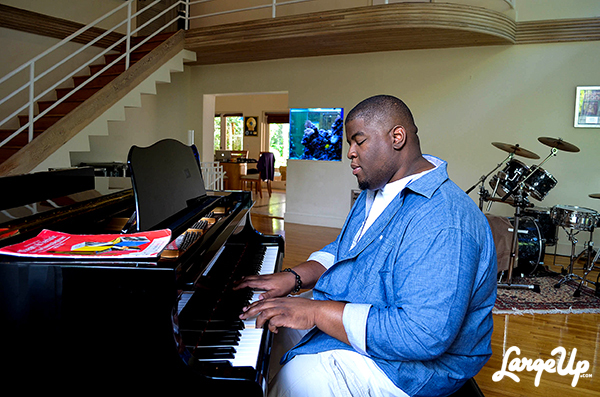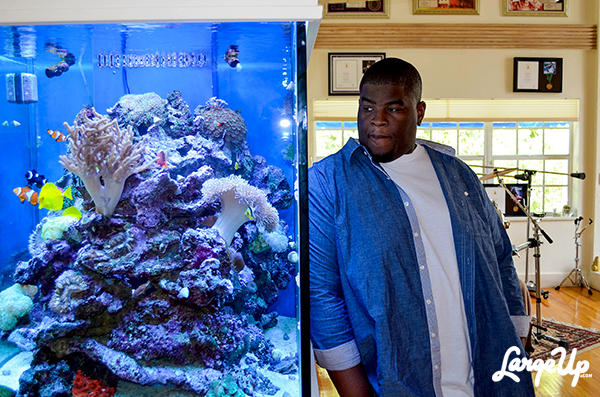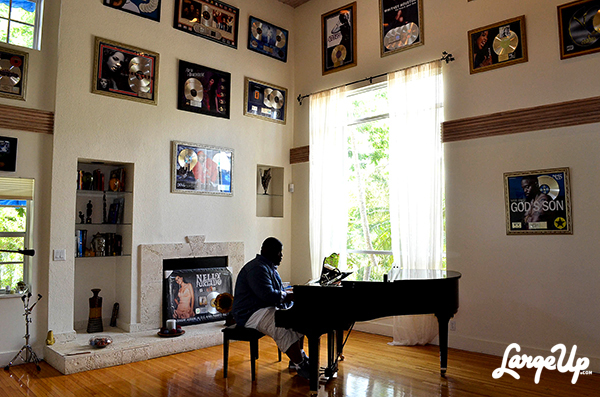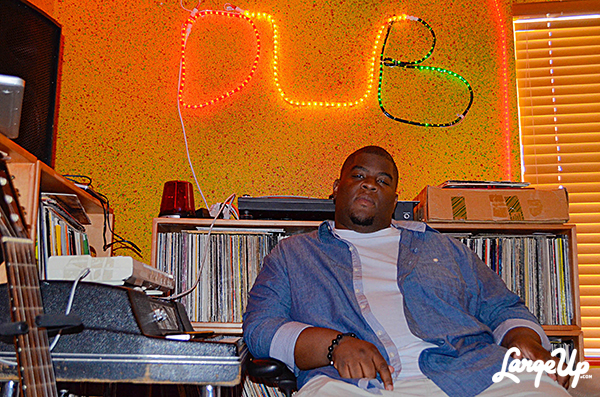LU: What is more rewarding, taking a veteran artist that’s got a lot of expectations riding on them, like a Nas, or taking a new artist that’s raw and making them into a career artist?
SR: I can’t say which one is more rewarding, but what has happened most often is I’ll work with artists from zero, negative zero, and help them become a brand artist. Nas is probably the only artist I work with that had a legacy already before we started working together. With the Fugees, I was really the pilot light that set it off and then their own artistry and talent was able to take it further. A big part of my goal is not to produce every record, my goal is to have it where they can produce themselves, and become producers for other artists. CJ Hilton will be a producer like Lauryn and Wyclef. They will be writers and producers of many artists to come throughout their career, so that’s important to me.
LU: Let me take you back a little bit. Tell me about your father, and who he is.
SR: My father is Van Gibbs. He was a musician in the Queens College scene, then he came up through the disco era, did Broadway, the Jazzmobile, then he worked on Tanya Gardner’s Work that Body album and a lot of pre-rap, NY scene disco records. He also arranged what became “Heartbeat.” That came 360 for me when I used it for [Ini Kamoze’s] “Here Comes the Hotstepper.” He was a New York promoter in the early 80’s— he was the first person to take Doug E. Fresh in the studio. He was cool with Sly and Robbie, so he pulled them together for a couple of records he was working on. He put the contest with radio together where they discovered the Fat Boys, and wound up producing the Fat Boys, Kurtis Blow. Up to now, he’s still a manager, managing Alison Hinds. He started managing Chuck Chillout, and Funkmaster Flex was a part of that crew. He used to help Flex out when Flex was just getting into radio. Then he used to produce the reggae show at WBLS with Pat McKay and Bobby Konders.
LU: So that’s where you linked with Bobby?
SR: I’d see Bobby in—rest in peace—Hal Jackson‘s records all the time looking for breaks. Bobby knew where everything was in the library, and he was also doing remixes. He had a day job at WBLS, and he was on the air. When people came into the station to give us records, most likely you gave it to Bobby because Bobby knew where all the music was. We were all at WBLS doing different stuff and through my dad I had known Marley Marl.
During the summers I spent with my dad as a kid, I saw hip-hop moving firsthand. My dad came into school with a Beat Street jacket on, driving the Knight Rider car and my friend was like, “Oh, he’s a muscle man, look.” Being he was a musician and my uncles were musicians, I understood that was a profession and what could happen. I could literally play a basic disco beat on drums, around ’75. Once I got out of high school running around at night with Flex or Bobby, I’m in the clubs seeing what’s happening first hand, from 89 forward. Bobby would call and say come to the studio and do a remix with me, I’ll throw you a G, and as a college kid at 18 I’m like “What!?!” I would take whatever [breakbeats] were just used in hip hop or I couldn’t have as exclusive breaks—’cause in hip hop nobody wants to use the same breaks somebody else has used—and put them into the reggae [remixes] with Bobby.

LU: That’s how that whole remix style started?
SR: That’s how it started being authentic ’cause people did hip-hop reggae before but I was able to make it the authentic hip-hop track you would have gotten for what whatever was happening then. I was taking that little hip-hop track and putting it on this other music. [Grand] Puba used James Brown for “Who Can Get Busy,” then I literally took it and put it on [Supercat’s] “Don Dada” remix and threw [Kool and the Gang’s] “Chocolate Buttermilk” underneath it. “Ghetto Red Hot” that was based on [De La Soul’s] “Bitties in the BK Lounge.” Brand Nubian’s “Punks Jump Up to Get Beat Down” wasn’t even out yet. It was like I’m gonna use this for hip-hop now. [I had my] stack of move it to reggae records. I was literally using everything going on in hip-hop and making it strong for that. I was also in the DJ booth with Bobby. Bobby at that time was one of the DJs I really looked up to. Bobby was great at that time at back spinning the house music into the reggae music into the R&B music, into the Hip Hop, or whatever was going on.
LU: I don’t really remember too many hip-hop remixes of reggae before that…
SR: You started getting that Kenny Dope stuff which was more loops off of the current hip-hop records put under reggae, and then the real official yard vocals on top of that. The biggest thing with me with remixes was I made sure everything was in key so it felt like the original record. Usually my remixes took over whatever the original was. Ini Kamoze’s “Here Comes the Hotstepper” was not done to “Heartbeat,” I put that on there. After that phase, I got bored and left it alone but I was still doing hip-hop, and other types of records. I decided to come back to reggae after being in the clubs again. I’d be in the booth with Flex, playlisting with him almost like the selector and the soundman. I had gotten bored with doing reggae the way we were doing it, cause you started getting records that weren’t really that good, and once you get those I back off. Then I was like I’m gonna start doing [reggae with] the [R&B] classics, cause we were doing the classics section in the club. That’s where [Mega Banton’s] “Soundboy Killing’ came from, with the Barry White. When Jack Scorpio came up and we were working on the Mega [Banton] album, I flipped the remix, and made that work, and then Ini had “Heartbeat,” Super Cat on “South Central” remix had [The Gap Band’s] “Outstanding.” I did “Rising to the Top” that Shabba put out, then Shabba came back with [a sample of Dennis Edwards’] “Don’t Look any Further” on the “Let’s Get It On” remix.
I was intentionally making songs there for a playlist for, now if you’re playing your classics you can go into your [hip-hop sample] reggae, then go into your other reggae, then back out, rather then playing your classics and now you gotta get into hip-hop and move it around. It was before it was even a trend in hip hop. Before Mary’s ‘My Life.’ When I was doing Super Cat’s [“South Central”] Puffy came in the studio like “heyyy yo, what are you doing?” Ini Kamoze’s “Here Comes the Hot Stepper” was the first No. 1 pop record with that 80’s thing. After that, everybody was would just take another 80’s record and throw it underneath there, but I get bored, and I didn’t really feel that in hip-hop. My hip-hop energy is like what you hear me do now. I wanted stuff that was gonna make you drive faster or make you wanna jump somebody. That energy of hip hop. And that’s what [Nas’] ‘A Queens Story’ is. I want you to speed when you hear that, you know doing doughnuts in a car with skirts on it.







